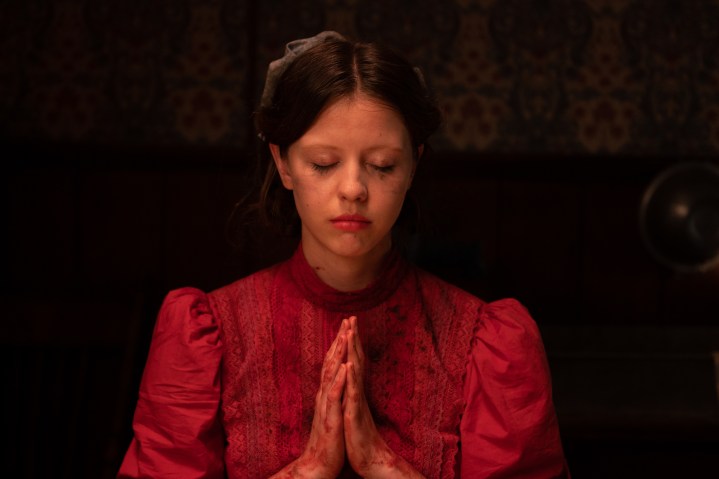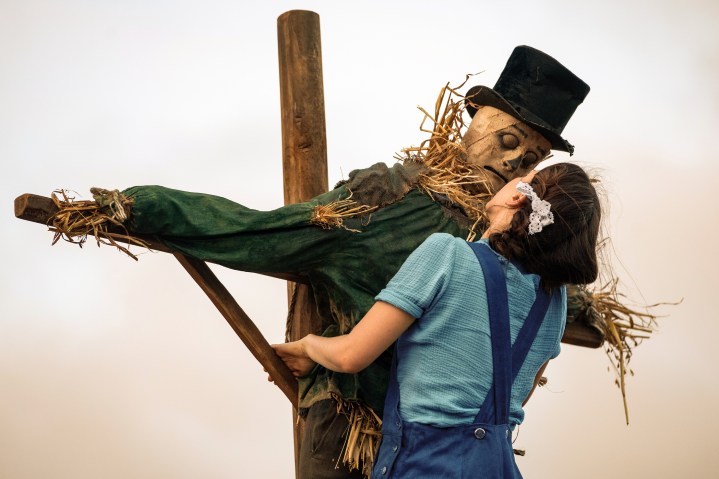Pearl is a candy-coated piece of rotten fruit. The film, which is director Ti West’s prequel to this year’s X, trades in the desaturated look and 1970s seediness of its parent film for a lurid, Douglas Sirk-inspired aesthetic that seems, at first, to exist incongruently with its story of intense violence and horror. But much like its titular protagonist, whose youthful beauty and Southern lilt masks the monster within, there’s a poison lurking beneath Pearl’s vibrant colors and seemingly untarnished Depression-era America setting.
Set around 60 years before X, West’s new prequel does away with the por nstars, abandoned farms, and eerie old folks that made its predecessor’s horror influences clear and replaces them with poor farmers, charming film projectionists, and young women with big dreams. Despite those differences, Pearl still feels like a natural follow-up to X. The latter film, with its use of split screens and well-placed needle drops, offered a surprisingly dark rumination on the horror of old age. Pearl, meanwhile, explores the loss of innocence and, in specific, the often terrifying truths that remain after one’s dreams have been unceremoniously ripped away from them.
At the center of both films is the lonely, impulsive serial killer that Mia Goth has now played at both the start and end of her life. In X, Goth’s dueling performances as Pearl and Maxine shione amid an array of memorable supporting turns from the film’s other stars. Pearl, conversely, puts Goth at the front and center of its story. In doing so, the film offers its star the chance to give one of the best and most vulnerable performances of the year so far.

Pearl begins in 1918, a year when many American men are still fighting the war overseas while those who are stateside have been left to grapple with the horror of the Spanish Flu. It’s a time that is capable of making anyone go a little mad, which is why it’s the worst — or perfect, depending on how you view it — environment for a young Pearl (Goth) to grow up in. When the film begins, Pearl is still living under the same suffocating roof as her domineering mother, Ruth (Tandi Wright), who makes her routinely bathe and feed her crippled father (Matthew Sunderland), all while Pearl is left to pray nightly for her husband, Howard (Alistair Sewell), to return home safely from the war.
Her poor relationship with her mother, combined with her own crushing loneliness, has made Pearl want nothing more than to get far, far away from her family’s farm. While she’s been able to stave off the suffocating mood of her life by routinely escaping into her own fantasies, a sudden act of cheerful, nonchalant violence in the film’s opening minutes makes it clear that Goth’s future serial killer is already on the brink of total collapse by the time Pearl catches up with her. As a result, the film’s script, which West and Goth co-wrote together, doesn’t take on the same slasher movie structure as X.
Instead, Pearl frequently feels like a kind of twisted coming-of-age story. In fact, like all the great heroes in all the great coming-of-age stories, the journey Pearl goes on throughout the film is one of self-acceptance. Over the course of Pearl‘s 102-minute runtime, she’s forced to let her defenses down and learn how to be vulnerable in front of others. The only problem is that the real Pearl, the one she hides beneath a smile that feels alternately mischievous and menacing, has a habit of scaring those around her — and for good reason.

Pearl’s descent into full-blown madness is juxtaposed quite effectively against the film’s bright Technicolor look. The resulting effect is one that makes Pearl seem, at times, like a horror film directed by French filmmaker Jacques Demy. The film’s sets are covered in bright pastel colors (an alleyway drainpipe is noticeably painted pink in one memorable scene) in a way that even calls to mind a film like The Umbrellas of Cherbourg, which still looks as if it had been designed to look as sweet and delectable as possible. That said, the film that Pearl has the most in common with is not The Young Girls of Rochefort or X, but Blue Velvet.
Like that 1986 David Lynch-directed classic, Pearl is interested in exploring the rot that lies beneath the surface of so many American archetypes. Pearl’s desperate desire to escape her hometown notably,places her in the same emotional space as practically every cinematic high schooler or Disney princess. But unlike so many of cinema’s other wanderlust-driven young protagonists, Pearl does not shine the longer she is left out in the sun. Instead, she sours, and so do her dreams, which start out innocently enough before growing increasingly violent and disturbing. The film, in turn, gradually replaces its pristinely painted red barns, golden scarecrows, and other pieces of familiar Americana iconography with recurring images of rotting hogs and half-burnt corpses.
Eventually, no matter how hard she tries to suppress it, there’s nowhere for Pearl’s growing instability to go other than to the surface. Once it does, Pearl begins to indulge more in the kind of blood-soaked horror and brutality that X fans may have been expecting all along. However, as impactful as much of the violence is in Pearl’s final third, it’s Goth’s red-faced, tear-streaked performance that ultimately takes center stage.

After opening with a delightfully macabre prologue, Pearl takes its time getting to the kind of violence and horror its story inherently promises. The film is a slow burn in a way that X very much wasn’t, which makes it far less superficially fun and rewatchable than West’s previous horror effort. Its second act, and especially the pace at which Pearl’s relationship with her mother develops, also drags in certain moments, which occasionally dulls the film’s overwhelming sense of unease.
But every time it seems like Pearl might get lost in the weeds of its own heightened vision of the past, Goth steps up and brings everything back into focus. The actress outdoes her work in X here, delivering a performance as Pearl’s lead that elicits both pity and fear, often at the same time. Her performance is so central to Pearl, in fact, that the film essentially climaxes with a long monologue that plays out almost entirely in one unbroken close-up of Goth’s mascara-smudged face. The scene might be the best of Goth’s career so far, and it’s followed by an instance of cold-blooded brutality that might be the most technically impressive sequence West has ever pulled off (you’ll know it when you see it).
From there, Pearl achieves a kind of operatic quality that manages to mostly justify the prolonged build-up. Whether or not the film’s climax makes it as effective as that of X will, however, likely vary depending on the tastes of its viewers. X made a lasting impression because of how it pulled its tropes from the wells of various horror classics only to twist them in ways that were often surprising and darkly funny. Pearl, on the other hand, frequently draws inspiration from movies and stories that are, at most, only tangentially related to the horror genre.
The resulting film is a sun-soaked and vibrant slice of technicolor horror that’s both more technically impressive and subtler than X. The film presents its horrors more nakedly than X does, but it traffics in a sense of unease that is far less visceral than the straightforward, slasher-driven violence of its predecessor. Neither approach is more valid than the other, but it’s a testament to West’s control of his craft that Pearl manages to cast the spell that it does, one that makes it impossible to look away even when the film’s rotten truths are literally staring you in the face.
Pearl hits theaters on Friday, September 16.



